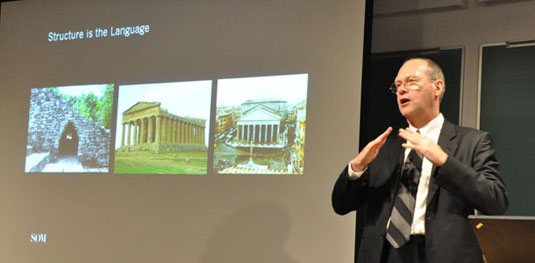Structural Engineer Bill Baker Proposes Design Philosophy

Watch a video of the lecture here.
If architecture is the story of a time and place, then the building’s structure is the language.
But we live in a time and place in which that language becomes jumbled: resources are limited, yet some strive for extreme, iconic architecture. It creates a conflict between rationality and inspired dreams, where the outcome takes the risk of being either staid and boring or willfully excessive.
Either way, the structural engineer should have an opinion, said Bill Baker, structural engineering partner of the Chicago architecture firm Skidmore, Owings & Merrill and an adjunct professor in McCormick’s Department of Civil & Environmental Engineering, during his Dean’s Seminar Series talk on Jan. 18.
“We shouldn’t just make it work,” he said of his fellow structural engineers.
Over his 30-year career, Baker has developed his own philosophy on design from working on such structures as James Turrell’s Roden Crater, a land art project wherein Turrell has turned the crater into an observatory and light experience. Baker helped create the structure for a lunar observatory and once described Turrell’s aesthetic as “Miesian simplicity.’ But Turrell disagreed: it was Quaker simplicity, he said, which got Baker thinking about the philosophy and morality of structures.
“Can structures have innate morality?” he asked. “Does the amount of material used have a moral dimension?”
Baker posed the question to students as he listed off the ideas he values in structures: efficiency, simplicity, minimalism, economy, elegance, utility, harmony, order and hierarchy, clarity, proportion, appropriateness, and rationality.
In fact, one of Baker’s favorite structures are the portable agricultural irrigation systems ubiquitous in Midwestern farm fields. The design is so elegant, he said, that his goal is to design some structure that is equally minimal and functional.
He then offered students practical advice about structural engineering; namely, if you want your designs to get built you have to have at least one idea of how to do it. To find this idea, don’t rely on computer software: structural engineers must know how buildings work, and when a computer designs a structure, the engineer is no longer in control of it.
And don’t be afraid to examine the ideas of the past: many of the world’s most innovative and attractive bridges were designed by structural engineers before our technology age. Know those who came before you, he said, and learn the theory behind the computation.
“We don’t need a computer to do beautiful things,” he said.